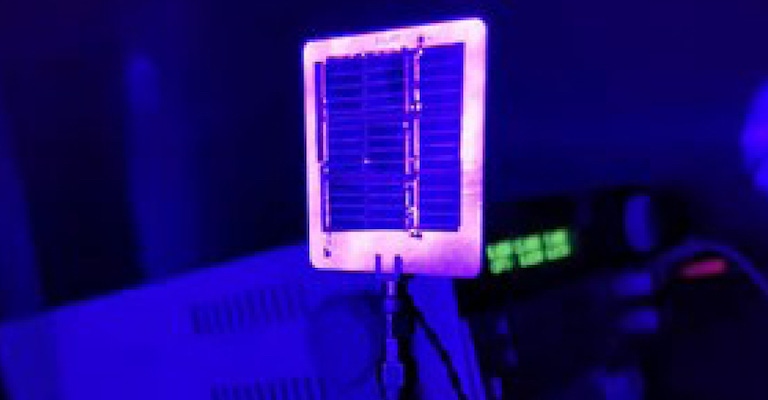Solar Cells Used for Rapid Underwater Wireless Communication
Researchers in China have developed an array of series-connected photovoltaic devices as detectors that they said can offer a cost-effective, low-energy way to transmit data.
May 10, 2022

Solar cells are known best for their ability to turn sunlight into electricity. However, scientists are discovering that they have a range of other uses, such as water desalination and a more recent discovery—to achieve underwater wireless optical communication with high data rates.
Researchers at Zhejiang University in China developed an array of series-connected solar cells as detectors that they said can offer a cost-effective, low-energy way to transmit data underwater. This could serve a current need for this type of communication to support ocean-protection activities that need to transmit data underwater, said Jing Xu, a professor at the university who led the research.
The system developed by Xu and his team uses commercially available solar cells to create an array that offers a larger optical-detection area than photodiodes, which traditionally have been used as detectors in wireless optical communication, he said.
One such use of the system, for example, would be to transmit data from divers, submarines, underwater sensors, and unmanned autonomous water vehicles to surface ships in coral-conservation efforts, Xu said.
Solving the Bandwidth Problem
Typical light-based underwater wireless communication exhibits higher speed, lower latency, and requires less power than communication-based on radio or acoustic waves. However, most long-distance high-speed optical systems are not practical for use underwater because they require strict alignment between the transmitter emitting the light and the receiver that detects the incoming light signal, researchers said.
Solar cells, however, can detect light from a large area and convert it to an electrical signal. Using them as detectors for underwater optical communication, then, can ease the requirement to place the transmitter and receiver in a specific alignment. However, so far it has been difficult to achieve high bandwidth because solar cells are optimized for energy harvesting rather than communication, researchers said.
Aware of these previous limitations, Xu’s team used modeling and simulation of connected solar cells to optimize the peripheral circuit, which significantly improved the performance of the solar cell-based detector researchers that developed, he said.
“Until now, achieving high-speed links using off-the-shelf silicon solar cells has required complex modulation schemes and algorithms, which need intense computing resources that use extra power and create a high processing latency,” Xu acknowledged in a press statement.
In tests, the solar-based system demonstrated both a large detection area and significant bandwidth for a commercial silicon solar panel-based optical communication system, researchers reported. “This type of system could even allow data exchange and power generation with one device,” Xu said.
Underwater Testing
To prove their system--which uses a 3x3 solar array to create a detection area of 3.4 × 3.4 centimeters—the team tested it in a 7-meter-long water tank that emulated an underwater channel.
Researchers used mirrors to extend the path length of the optical signal, creating a transmission distance of 35 meters. In the tests, the system showed reliable stability, low power consumption, and high performance, they said.
Detection bandwidth was also higher—and thus enabled a higher data rate—than in previous attempts to use commercial silicon solar cells with a large detection area as detectors, the team reported in a paper on their work in the journal Optics Letters. As they increased the size of the solar array from 1×1 to 3×3, the −20-dB bandwidth increased from 4.4 megahertz (MHz) to 24.2 MHz.
Moreover, by applying a reverse bias voltage of 90 volts, researchers boosted the bandwidth further, to a −20-dB bandwidth of 63.4 MHz, they said. This bandwidth facilitated a 35-m/150-Mbps underwater wireless optical link using the simplest form of amplitude-shift keying modulation, researchers reported.
Uses and Future Development
Researchers envision that the system not only has uses for underwater communication but also for visible light communication, a type of wireless communication that uses visible light from LEDs and other sources to transmit data across distances, Xu said.
“Because solar cells are mass-produced, the proposed scheme is quite cost-effective,” he said in a press statement.
The team plans to study the system’s performance with weak optical signals to optimize the system further for real-world applications in underwater communication. This will demonstrate how well it works in muddy or moving water, researchers said.
Researchers also aim to make the system more practical by fine-tuning key parameters, such as the number of solar cells in the array and the required reverse bias voltage, they said.
Elizabeth Montalbano is a freelance writer who has written about technology and culture for more than 20 years. She has lived and worked as a professional journalist in Phoenix, San Francisco, and New York City. In her free time, she enjoys surfing, traveling, music, yoga, and cooking. She currently resides in a village on the southwest coast of Portugal.
About the Author(s)
You May Also Like





